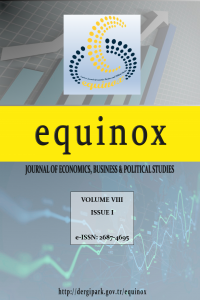The Impact of Food Inflation on Poverty in Turkey
Bu çalışma gıda enflasyonu ile yoksulluk arasındaki ilişkiyi 2016-2019 yılları arasındaTürkiye özelinde TÜİK’in Hanehalkı Bütçe Anketi kullanılarak analiz etmektedir. Bu analizi yaparken çok terimli logit regresyon modeli kullanılmıştır. Bu modelde yoksulluk sınırı bağımlı değişken olarak ele alınırken, bağımsız değişkenler ise gıda enflasyonu, hane halklarının yapısı, harcaması, yaşadıkları mülkiyetteki durumu, ödenilen kira tutarları sigara ve alkol alışkanlığı, özel sigorta yaptırıp yaptırmadıkları, kredi kartı kulanımı, pazara gitme alışkanlıklarıdır. Bunların yanı sıra ülkedeki yoksul olma durumunun ölçülmesinde kullanılan cep telefonu, bilgisayar, televizyon, buzdolabı, bulaşık ve çamaşır makinesi, otomobil sayısı ve dışarıda ne kadar yemek yenildiği de açıklayıcı değişken olarak kullanılmıştır. Sonuç olarak gıda fiyatlarındaki artışın yoksulluğu arttırdığı görülmüştür.
The Impact of Food Inflation on Poverty in Turkey
This study analyzes the relationship between food inflation and poverty between the years of 2016-2019 in Turkey, using the Household Budget Survey of TÜİK.. The multinomial logit regression model was used for this analysis. In this model, while the poverty line is considered as the dependent variable, the independent variables are food inflation, the structure and expenditure of households, the status of the property they live in, rent amounts paid, smoking and alcohol habits, whether they have private insurance, credit card usage, and shopping habits. In addition to these, mobile phones, computers, televisions, refrigerators, dishwashers and washing machines, number of cars and how much food is eaten outside were used as explanatory variables to measure poverty in the country. As a result, it has been seen that the increase in food prices increases poverty.
___
- Bozma, K., Bozma, G. & Güney, A. (2020). Enflasyon ve işsizliğin yoksulluk üzerindeki etkisi: Türkiye düzey-1 bölgeleri örneği. KAÜİİBFD, 11(22), 973-996.
- Blejer, M. I., and I. Guerrero, (1990), "The Impact of Macroeconomic Policies on Income Distribution: An Empirical Study of the Philippines," Review of Economics and Statistics 414-423
- Bulir, A. (2001). “Income Inequality: Does Inflation Matter?”, IMF Staff Papers Vol. 48, No. 1
- Çagatay, S. ve M.Mert (2016). Yapısal Sorunlar Perspektifinden Gıda Enflasyonu, TÜSİAD-yayınları , T/2016,09 – 578, İstanbul.
- Dağdemir, Ö. (2002) “Türkiye Ekonomisinde Yoksulluk Sorunu Ve Yoksulluğun Analizi : 1987 – 1994“,C.C.Aktan (Ed.), Yoksullukla Mücadele Stratejileri, Ankara: Hak-İş Konfederasyonu Yayını
- Datt, G. ve M.Ravallion (1998). “Has India’s Economic Growth Become More Pro-Poor in the Wake of Economic Reforms?”, The World Bank Economıc Revıew, Vol. 25, No. 2, Pp. 157–189
- Deaton, A. (1989), “Rice Prices and Income Distribution in Thailand: A Non-parametric Analysis”, Economic Journal, 99 (395), 1-37.
- De Hoyos, Rafael. E. and Denis Medvedev. (2009). “Poverty Effects of Higher Food Prices: A Global Prospective.” Policy Research Working Paper No. 4887. The World Bank, Washington DC.
- Easterly, W. ve S.Fischer (2000). Inflation and the Poor, Policy Research Workıng Paper 2335, The World Bank Development Research Group Macroeconomics and Growth and International Monetary Fund
- FAO, “FAO Food Price Index”, http://www.fao.org/worldfoodsituation/foodpricesindex/en, (Erişim tarihi: Agustos 2021).
- Ferreıra, F. H. G., ,P. G. Leıte ve J.A. Lıtchfıeld (2001). “The Rise and Fall of Brazilian Inequality: 1981–2004”, Macroeconomics Dynamics, 12 (2), 199-230.
- Galli, R, ve Hoeven, R (2001). “ Is inflation bad for income inequality: The importance of the initial rate of inflation”, Employment Paper, 29.
- Ivanic, M. ve W. Martin (2008), “Implications of higher global food prices for poverty in low-income countries”, Agricultural Economics 39, supplement 405–416.
- Romer, C.D. ve D.H. Romer (1998) “Monetary Policy and the Well-Being of the Poor.” NBER Working Paper 6793.
- Shrestha, B. Ve S. K. Chaudhary (2012) “The Impact of Food Inflation on Poverty in Nepal”, NRB Economic Review,
- StataCorp. (2019). Stata Statistical Software: Release 16. College Station, TX: StataCorp LLC.
- Sturdivant, R., Lemeshow, S. and Hosmer, D., (2013). Applied Logistic Regression. 3rd ed. New Jersey: John Wiley & Sons, Inc, pp.269-283.
- TÜİK (2012) , İstatistik Göstergeler Statistical Indicators 1923-2011 , Türkiye İstatistik Kurumu, Yayın No: 3890, ISBN 978-975-19-5571-5, Ankara
- TÜİK, (2021a), Gelir ve Yaşam Koşulları Araştırması. Sayı 37404 (https://data.tuik.gov.tr/Bulten/Index?p=Gelir-ve-Yasam-Kosullari-Arastirmasi-2020-374049
- TÜİK (2021b) Sürdürülebilir Kalkınma Göstergeleri, 2010-2019 https://data.tuik.gov.tr/Bulten/Index?p=Sustainable-Development-Indicators-2010-2019-37194
- TÜİK (2021c) İstatistik veri portalı https://data.tuik.gov.tr/Kategori/GetKategori?p=Enflasyon-ve-Fiyat-106
- Vu, L. ve P. Glewwe, (2011). “Impacts of Rising Food Prices on Poverty and Welfare in Vietnam”, Journal of Agricultural and Resource Economics, 36 ( 1), 14-27.
- Walsh, J. P. and Jiangyan Yu (2012) “Inflation and Income Inequality: Is Food Inflation Different? “, IMF Working Paper, WP/12/147
- Yavuz, F. (2021). “Türkıye’de Gıda Enflasyonu Tarladan Çatala Sorunların Bır Göstergesı”, SETA (Siyaset, Ekonomi Ve Toplum Araştırmaları Vakfı) Yayınları 185, İstanbul
- Yıldırım, Ali Ekber (2021). Dünya gıda fiyatlarındaki artışın Türkiye’ye yansıması 3 Şubat 2021 https://www.dunya.com/kose-yazisi/dunya-gida-fiyatlarindaki-artisin-turkiyeye-yansimasi/609499
- Yayın Aralığı: Yılda 2 Sayı
- Başlangıç: 2019
- Yayıncı: Siirt Üniversitesi
Sayıdaki Diğer Makaleler
The Impact of Food Inflation on Poverty in Turkey
The Effect of Real Effective Exchange Rate on Imports and Exports: The Case of The Fragile Five
Youth’s View on Gender Based Glass Ceiling & Glass Cliff Phenomenon
Sağlık Göstergelerinin Ekonomik Büyüme Üzerine Etkisi: E7 Ülkelerinden Kanıtlar
